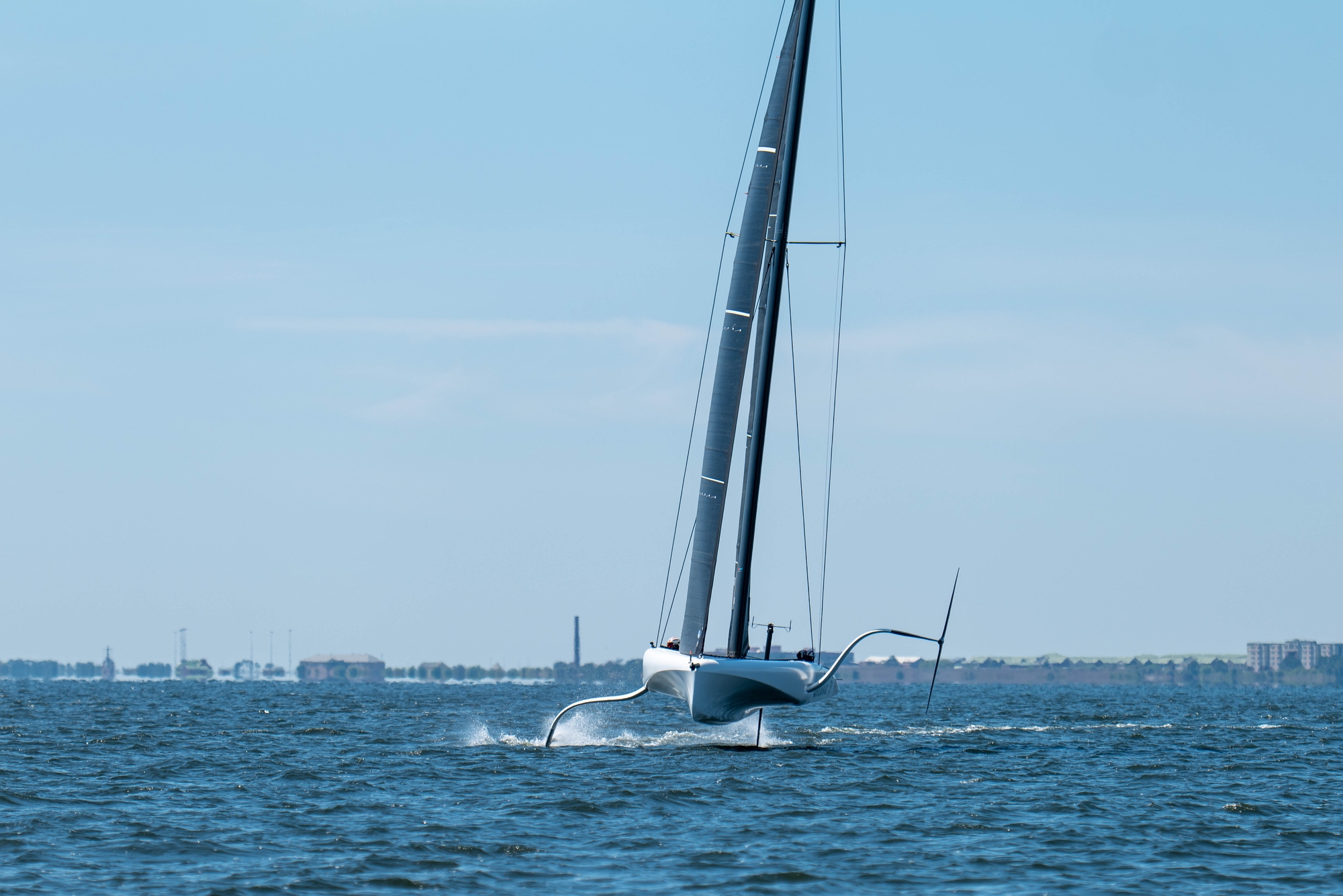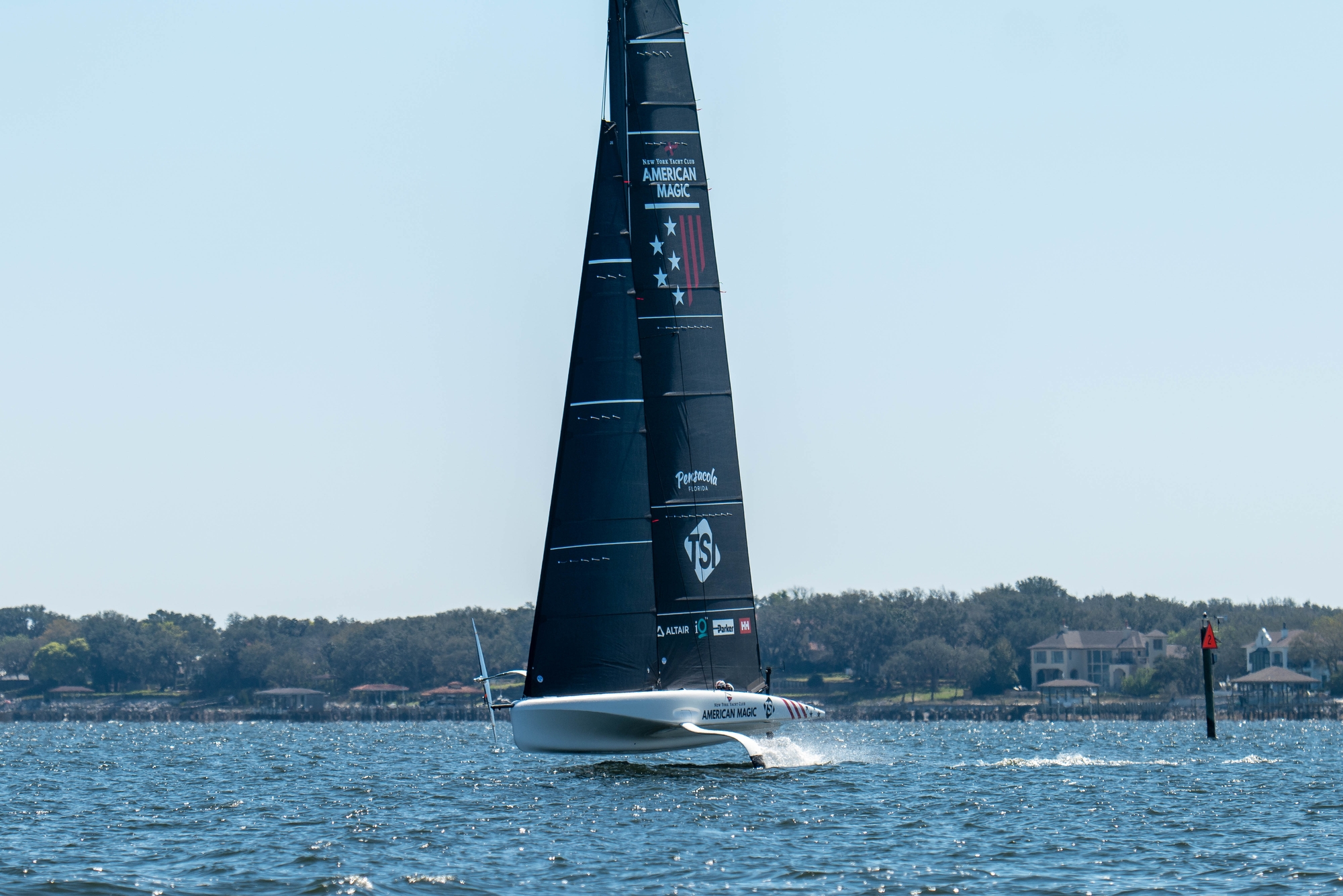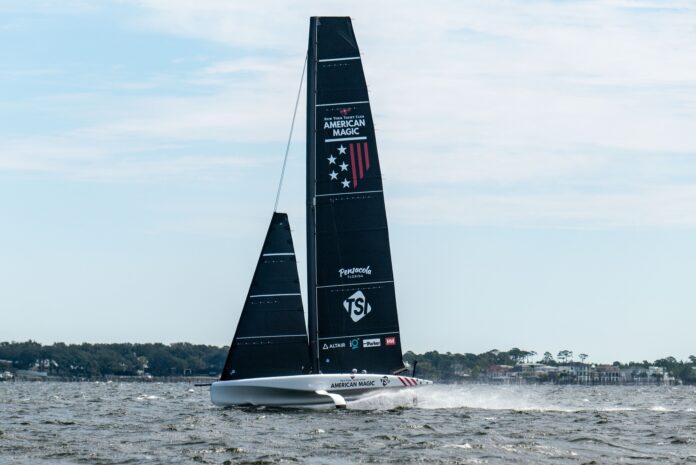The speed at which New York Yacht Club American Magic went from one-design to LEQ12 mode on their AC40 perhaps gives a clue to just how advanced the American programme is after a brilliant winter of testing in Pensacola Bay.
Today called for a mid-morning dock-out to catch a decent early morning breeze that was always set to die off into the afternoon, but these are the days that count. Grabbing even a few hours on a shifty, fading northerly breeze is of the utmost value with the design office keen to validate their thinking and calibrate what they see on the computer with what happens on the water in real-time. It’s an intense period for the Americans who continue to take big steps forward after de-commissioning Patriot, the team’s AC75 from AC36 where systems were honed at full-scale before the foil design race started in earnest with the AC40 at the weekend.

Today, the team were in full test mode, keen to examine take-offs, cant sweeps, pitch and speed through a whole host of manoeuvres and straight-lines. The new starboard foil was very much the focus and the recon unit recorded that at times: “America seemed to struggle to self-foil on port tack in particular.” Michael Menninger, always brilliant in interview and one of the first names on the crew-list for the team as Flight Controller, summed up the noted issue saying: “Honestly, I don’t think it’s a foil thing at all. I think it was just the way the breeze was, it was really up and down, and we had a J3 on for a lot of the morning and for the dying breeze, so it was just hard to get up.”

And Michael summed up the day and the testing eloquently, saying: “It was a pretty tricky day, it was a dying northerly…so we just tried to get out early enough to make the most of it and get some good breeze in. We had our ups and downs, but I think we got enough out of it today…It obviously gets more challenging when you get variances in the breeze but with this configuration we have two trimmers, so we’re trying to trying to utilise the leeward trimmer and the windward trimmer as much as we can and just using good communication to get us through puffs and lulls and mode the boat appropriately.”
Asked whether he could feel a speed difference with the new foil, Michael clearly felt the team were moving in the right direction saying: “It’s a bit early to tell. Today was day two on the foil and we’re just trying to gather as much data as we can and compare it to the One- Design foil but so far, it’s looking like an improvement which is obviously a good thing. It’s good for us to take a step forward there and we’ve just got to keep sailing on it.”

On a day where structured training or tasks was always going to be a challenge in the breeze, American Magic did a good job ticking off items on the agenda as Michael alluded, saying: “We did want to get some light air take-offs on the new foil which we were pleased to get, and just trying to get more hours and more data on the new foil, nothing really specific just trying to get more comfortable with it and make sure all the calibrations are well.”
Over a session that last just in excess of three hours, the Magic team threw in a healthy 43 manoeuvres with the vast majority foil-to foil or touch & go whilst staying in flight for some 47 minutes as the team opted for shorter high velocity runs. Valuable data gathering for the analysts, great practice on take-offs for the sailors and the programme will continue at pace this week. American Magic are impossible to ignore.

On-Water Recon Unit Notes: The shore crew took about 15 minutes longer than usual to step the mast shortly after roll-out at 8am. America was craned in at 9:20 and docked out at 10:02. The crew spent around 15 minutes longer than usual to raise the main. Sailing began at 11:11 in 39-degree temperatures. The sailing stints were quite brief all day, with frequent touch downs, and the longest stint was 10 minutes.
The J3 was swapped for the J1 at 11:30 as the velocity decreased to 8-12k. America seemed to struggle to self-foil on port tack in particular (even before the breeze started to decrease). The team spent upwards of 10 minutes at a time trying to self-foil, but not opting for a tow up.
America touched down at 12:10 after the jib Tylaska broke. The battery was changed at 13:00. Shortly after a take-off, America had a moderate bow stuff at 13:20. The team sailed a few more briefs stints until an end to sailing was called at 13:25.
In all, America completed 43 manoeuvres, 7 windward/leewards, sailed approximately 30nm, and had a flying time of 47min. Top speeds were approximately 28k upwind and 36k downwind.
Total Tacks: 30 – 21 foil-to-foil, 4 touch & go, 5 touchdowns.
Total Gybes: 13 – 12 foil-to-foil, 1 touch & go.
Recon Notes: America was on foil for a total of 47 minutes (5, 1, 3, 1, 1, 3, 10, 6, 3, 5, 3, 1, 2, and 3 minutes respectively)
Take off speed: 17 knots at 100° TWA (True Wind Angle)
Recon Notes: Initial take off was self, 16 additional self up’s, 0 tow up’s
Onboard AC40 Today:
Helms: Paul Goodison / Riley Gibbs
Trimmers: Lucas Calabrese / Michael Menninger
Conditions: 10:24 NE 12-15k/ 11:27 NE 10-12/ 11:51 NE 5k/ 12:16 NE 8-10k/ 13:11 NE 8-10. Wind speed measured 8ft above sea level using a handheld anemometer. Weather AM: 39° sunny. Weather PM: 55° sunny. Sea State: 1-2ft chop
Sails Used:
M1 (AM-MN1): 3 hours 15 minutes
J1: 2 hours 5 minutes
J3: 39 minutes
Dock-Out: 1002 Dock-In: 1357






